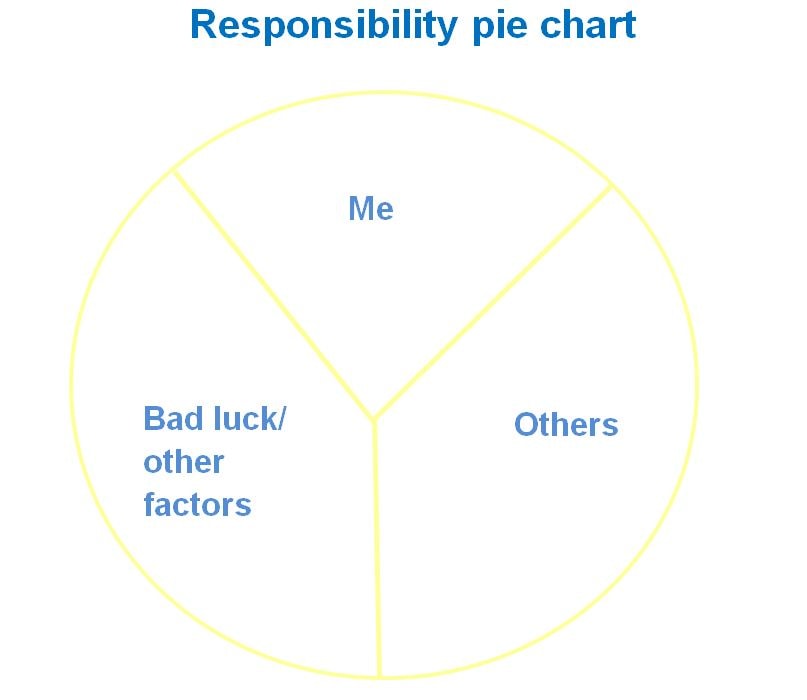A responsibility pie chart (RPC) is a psychological tool that explains the role three factors (own actions, others’ actions and unpredictable factors) have on the outcome of a situation. It’s particularly useful in explaining negative situations, and in helping students to see that many parties have responsibility and to attribute responsibility beyond themselves. During this lesson, students use the RPC to understand the shared responsibility of different individuals (e.g. yourself, others and unpredictable factors) in influencing the outcomes of situations.

Year level
7-10

Duration
60 minutes

Type
In class activity
Online learning

SEL Competencies
Self-awareness
Self-management
Social awareness
Relationship skills
Learning intention
Students will learn that many factors contribute to the outcome of a situation.
Key outcomes
By the end of the lesson, students will be able to:
understand the responsibility pie chart
analyse the different factors that contribute to outcomes in a difficult situation
understand how their own behaviour contributes to outcomes in situations
explain the different factors that contribute to different outcomes in situations.
Materials needed
Paper and pen
Mapped to
Australian Curriculum: Health and Physical Education
Investigate the benefits of relationships and examine their impact on their own and others’ health and wellbeing (ACPPS074)
Evaluate situations and propose appropriate emotional responses and then reflect on possible outcomes of different responses (ACPPS094)
Australian Curriculum: General Capabilities
Personal and social capability:
Social awareness
Critical and creative thinking:
Reflecting on thinking and processes
NSW PDHPE Syllabus
Investigates effective strategies to promote inclusivity, equality and respectful relationships (PD4-3)
Critiques their ability to enact interpersonal skills to build and maintain respectful and inclusive relationships in a variety of groups or contexts (PD5-10)
Victorian Curriculum: Health and Physical Education
Investigate the benefits of relationships and examine their impact on their own and others’ health and wellbeing (VCHPEP127)
Investigate how empathy and ethical decision-making contribute to respectful relationships (VCHPEP146)
Activity 1
Case study: Friendships and responsibility
40 minutes
1. Explain to students that you will read out a case study.
2.Read the case study (either ‘Sam’s story’ or ‘Zoe/Ella’s story’):
Sam’s story: Sam’s mother saw him pack his best sunglasses for the school camp. They were a very expensive pair that he had bought with the money he earned from his part-time job. His mum suggested that he leave them at home in case they got stolen or broken at the camp, but Sam insisted on taking them. When he returned from camp, his mother was waiting for him in the ‘5 minutes only’ parking zone because it was raining. As soon as Sam got off the bus, she signalled to him to hurry so she wouldn’t be booked. He hurried over, laden down with his backpack, sleeping bag and pillow. As he ran up to the door of the car, his sunglasses fell out of his jacket pocket and dropped into the stormwater drain by the side of the road. Sam was devastated. His mother said, ‘I told you not to take them.’ OR
Zoe/Ella’s story: A group of Year 9 girls were chatting and laughing when Ella noticed that Zoe, another girl in the group, was taking photos of her with her mobile phone. Ella was angry that Zoe hadn’t asked her if that was okay and tried to grab Zoe’s phone to stop her. The phone was dropped and the screen broke. Both girls started to yell at each other and a teacher came to investigate.
3. Ask students to discuss:
How much of the responsibility is Sam/Ella’s (express in percentage terms)?
How much of the responsibility is Sam’s mum’s/Zoe’s?
How much is due to factors outside of their control?
How much is due to bad luck or circumstances?
Draw a pie chart showing each party’s percentage of responsibility.
Could anything have been done to change the outcome? Is this realistic?
Debrief: While taking responsibility is important, it’s also worth remembering that there are often factors outside of your control that can lead to an outcome. Sometimes, some steps can be taken to reduce the impact of those factors (e.g. Ella could have approached a teacher, or Sam could have chosen not to take his sunglasses on the trip), but sometimes the situation is outside of an individual's control. When bad things happen, remind students to reflect on the responsibility of other parties, and to acknowledge the role of back luck or circumstances and others in the outcome of the situation.
Activity 2
Responsibility pie chart
20 minutes
1. Explain to students that a responsibility pie chart helps to explain the role of your actions, the actions of others and unpredictable factors in determining the outcome of a situation.
2. Ask students to think about a recent activity they completed and to make dot points listing (in percentage form) how responsible they think the following factors were in determining the outcome:
their own actions (e.g. 55 per cent)
the actions of others (e.g. 15 per cent)
factors outside of their control (e.g. 30 per cent).
3. Students then draw a circle and record the percentages for ‘me’, ‘others’ and ‘bad luck/other factors’.
4. Explain to students that there is no right or wrong answer, because each person interprets situations, and who is responsible for them, differently.
5. Divide students into groups and ask them to share with their group members why they assigned that particular percentage of responsibility for each of ‘me’, ‘others’ and ‘bad luck/other factors’.





